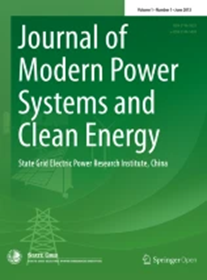Low-Frequency Impedance Modeling of Wind Energy Conversion System Considering Mechanical Dynamics and Operating Regions
IF 6.1
1区 工程技术
Q1 ENGINEERING, ELECTRICAL & ELECTRONIC
Journal of Modern Power Systems and Clean Energy
Pub Date : 2025-01-30
DOI:10.35833/MPCE.2024.000518
引用次数: 0
Abstract
Oscillation accidents emerge in power systems integrated with increasing penetration of renewable energy sources. The impedance of electromagnetic dynamics is investigated in recent years, where the mechanical dynamics are neglected. So far, the low-frequency oscillations are not well addressed with the impedance analysis method. A novel analytical impedance is formulated and implemented for wind energy conversion system consisting of wind turbine generators (WTGs) and wind farm, which fills the gap in the mechanical dynamics of the impedance. Instead of assuming constant values, the electromechanical dynamics of the rotor speed and the pitch angle are involved in the WTG impedance. Besides, the impedance framework is generally and modularly designed and is adaptive to different operating regions. With the developed analytical impedance, the stability assessment can cover the low-frequency oscillations, providing an in-depth insight into the mechanical parameters influencing the small-signal stability performance. As an application, the impedance characteristic and stability performance of systems with active power reserve for grid supporting are analyzed and optimized. Furthermore, the shafting torsional vibrations of WTGs in wind farms are analyzed with modal decomposition and the low-frequency impedance model. The improved accuracy of the developed analytical impedance is illustrated by comparison with commonly used impedance, which ignores the coupling between the electrical and mechanical dynamics. It is proven that the mechanical dynamics have a significant influence on the impedance, particularly in the low-frequency range. Experimental validation is carried out to validate the low-frequency impedance model and the stability performance.考虑机械动力学和工作区域的风能转换系统低频阻抗建模
随着可再生能源的日益普及,电力系统中出现了振荡事故。近年来,人们对电磁动力学中的阻抗问题进行了研究,而忽略了机械动力学。到目前为止,阻抗分析方法还不能很好地解决低频振荡问题。针对由风力发电机组和风电场组成的风能转换系统,提出并实现了一种新的解析阻抗,填补了阻抗力学动力学方面的空白。在WTG阻抗中,转子转速和俯仰角的机电动力学不是假设恒定值,而是涉及到WTG阻抗。此外,阻抗框架采用通用模块化设计,可适应不同的工作区域。随着分析阻抗的发展,稳定性评估可以涵盖低频振荡,从而深入了解影响小信号稳定性性能的力学参数。作为应用,分析并优化了电网有功备用系统的阻抗特性和稳定性。在此基础上,利用模态分解和低频阻抗模型对风力发电机组轴系扭振进行了分析。与忽略电动力学和机械动力学耦合的常用阻抗相比,本文所提出的分析阻抗的精度得到了提高。实验证明,机械动力学对阻抗有显著的影响,特别是在低频范围内。实验验证了低频阻抗模型的正确性和稳定性。
本文章由计算机程序翻译,如有差异,请以英文原文为准。
求助全文
约1分钟内获得全文
求助全文
来源期刊

Journal of Modern Power Systems and Clean Energy
ENGINEERING, ELECTRICAL & ELECTRONIC-
CiteScore
12.30
自引率
14.30%
发文量
97
审稿时长
13 weeks
期刊介绍:
Journal of Modern Power Systems and Clean Energy (MPCE), commencing from June, 2013, is a newly established, peer-reviewed and quarterly published journal in English. It is the first international power engineering journal originated in mainland China. MPCE publishes original papers, short letters and review articles in the field of modern power systems with focus on smart grid technology and renewable energy integration, etc.
 求助内容:
求助内容: 应助结果提醒方式:
应助结果提醒方式:


